2023 SUBARU BRZ turn signal
[x] Cancel search: turn signalPage 186 of 432
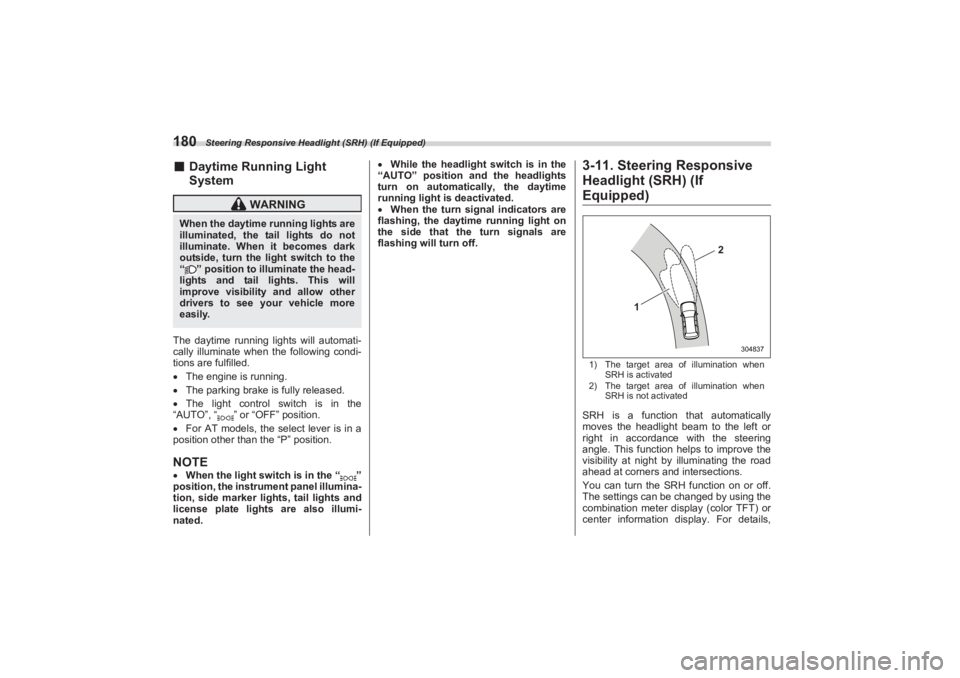
Steering Responsive Headlight (SRH) (If Equipped)
180■Daytime Running Light
SystemThe daytime running lights will automati-
cally illuminate when the following condi-
tions are fulfilled.
The engine is running.
The parking brake is fully released.
The light control switch is in the
“AUTO”, “ ” or “OFF” position.
For AT models, the select lever is in a
position other than the “P” position.NOTE When the light switch is in the “ ”
position, the instrument panel illumina-
tion, side marker lights, tail lights and
license plate lights are also illumi-
nated.
While the headlight switch is in the
“AUTO” position and the headlights
turn on automatically, the daytime
running light is deactivated.
When the turn signal indicators are
flashing, the daytime running light on
the side that the turn signals are
flashing will turn off.
3-11. Steering Responsive
Headlight (SRH) (If Equipped)1) The target area of illumination when
SRH is activated
2) The target area of illumination when
SRH is not activatedSRH is a function that automatically
moves the headlight beam to the left or
right in accordance with the steering
angle. This function helps to improve the
visibility at night by illuminating the road
ahead at corners and intersections.
You can turn the SRH function on or off.
The settings can be changed by using the
combination meter display (color TFT) or
center information display. For details,
WARNING
When the daytime running lights are
illuminated, the tail lights do not
illuminate. When it becomes dark
outside, turn the li ght switch to the
“ ” position to illuminate the head-
lights and tail lights. This will
improve visibility and allow other
drivers to see your vehicle more
easily.
1
2
304837
BRZ_U.book 180 ページ 2022年3月29日 火曜日 午後3時59分
Page 188 of 432

Headlight Beam Leveler
1823-12. Headlight Beam LevelerThe LED headlights produce more light
than conventional halogen headlights.
When the vehicle is carrying a heavy load
and the headlight beams are angled
upwards, the driver of an oncoming
vehicle may experience glare.
To prevent this, the automatic headlight
beam leveler adjusts the headlights to the
optimum height automatically depending
on the load the vehicle is carrying.
3-13. Turn Signal Lever1) Right turn
2) Lane change right signal
3) Lane change left signal
4) Left turnTo activate the turn signal:
Pushing the turn signal lever up/down and
releasing it activates the turn signal. Then
the lever returns to its original position.
To cancel the turn signal:
Push and release the turn signal lever
slightly in the opposite direction of the
active turn signal. To signal a lane change:
1. Push the turn signal lever up or down
slightly.
2. Hold in the signal lever during the lane
change.
The turn signal indicator lights will flash in
the direction of the turn or lane change.
The lever will return automatically to the
neutral position when you release it.
■ One-Touch Lane ChangerTo flash the turn signal and turn signal
indicator light three times, push the turn
signal lever up or down slightly and imme-
diately release it.NOTEThe operational/non-operational set-
ting of the one-touch lane changer can
be changed by a SUBARU dealer. Con-
tact the nearest SUBARU dealer for
details. The setting can also be
changed by operating the center infor-
mation display. For details, refer to
"Car settings" P165
CAUTION
In certain circumstances, the head-
lights may become misaligned, and
the headlight beam leveler will not
reset them to the proper angle. This
may occur after transporting your
vehicle on a flat-bed truck, or if the
vehicle is parked and restarted on
different angles. In such cases,
have the headlight alignment
checked by a SUBARU dealer.
2
3 41
306967
BRZ_U.book 182 ページ 2022年3月29日 火曜日 午後3時59分
Page 193 of 432
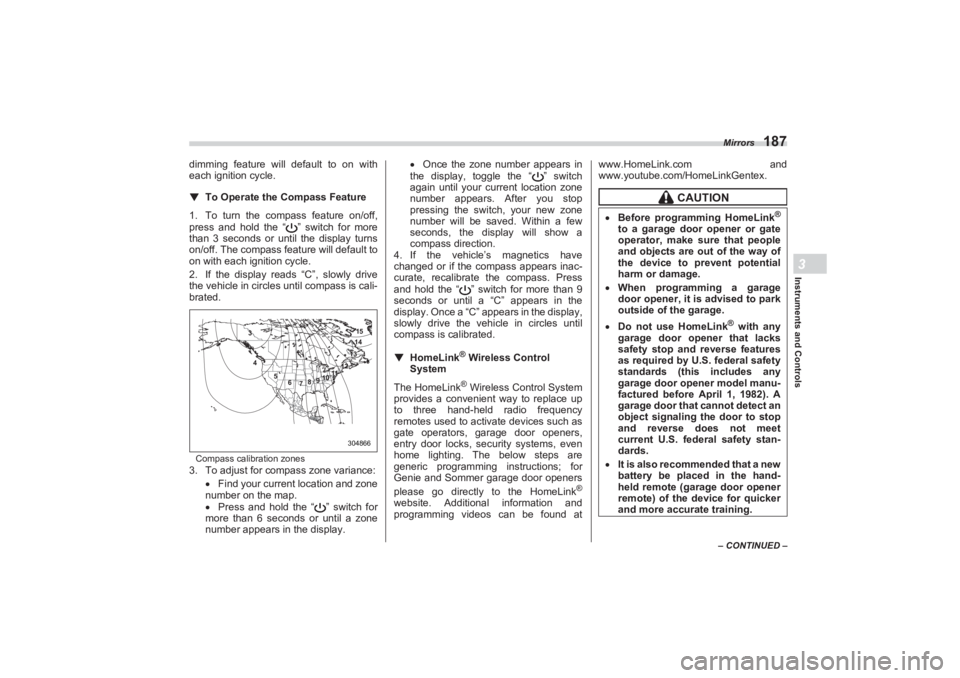
Mirrors
187
Instruments and Controls3
– CONTINUED –
dimming feature will default to on with
each ignition cycle.▼ To Operate the Compass Feature
1. To turn the compass feature on/off,
press and hold the “ ” switch for more
than 3 seconds or until the display turns
on/off. The compass feature will default to
on with each ignition cycle.
2. If the display reads “C”, slowly drive
the vehicle in circles until compass is cali-
brated.Compass calibration zones3. To adjust for compass zone variance:
Find your current location and zone
number on the map.
Press and hold the “ ” switch for
more than 6 seconds or until a zone
number appears in the display.
Once the zone number appears in
the display, toggle the “ ” switch
again until your current location zone
number appears. After you stop
pressing the switch, your new zone
number will be saved. Within a few
seconds, the disp lay will show a
compass direction.
4. If the vehicle’s magnetics have
changed or if the compass appears inac-
curate, recalibrate the compass. Press
and hold the “ ” switch for more than 9
seconds or until a “C” appears in the
display. Once a “C” a ppears in the display,
slowly drive the vehicle in circles until
compass is calibrated.
▼ HomeLink
® Wireless Control
System
The HomeLink
® Wireless Control System
provides a convenient way to replace up
to three hand-held radio frequency
remotes used to acti vate devices such as
gate operators, garage door openers,
entry door locks, se curity systems, even
home lighting. The below steps are
generic programming instructions; for
Genie and Sommer garage door openers
please go directly to the HomeLink
®
website. Additional information and
programming videos can be found at www.HomeLink.com and
www.youtube.com/HomeLinkGentex.
304866 15
14
13
12
11
10
9
8
7
6
5
4
3
CAUTION
Before programming HomeLink
®
to a garage door opener or gate
operator, make sure that people
and objects are out of the way of
the device to prevent potential
harm or damage.
When programming a garage
door opener, it is advised to park
outside of the garage. Do not use HomeLink
® with any
garage door opener that lacks
safety stop and reverse features
as required by U.S. federal safety
standards (this includes any
garage door opener model manu-
factured before April 1, 1982). A
garage door that cannot detect an
object signaling the door to stop
and reverse does not meet
current U.S. federal safety stan-
dards.
It is also recommended that a new
battery be placed in the hand-
held remote (garage door opener
remote) of the device for quicker
and more accurate training.
BRZ_U.book 187 ページ 2022年3月29日 火曜日 午後3時59分
Page 196 of 432
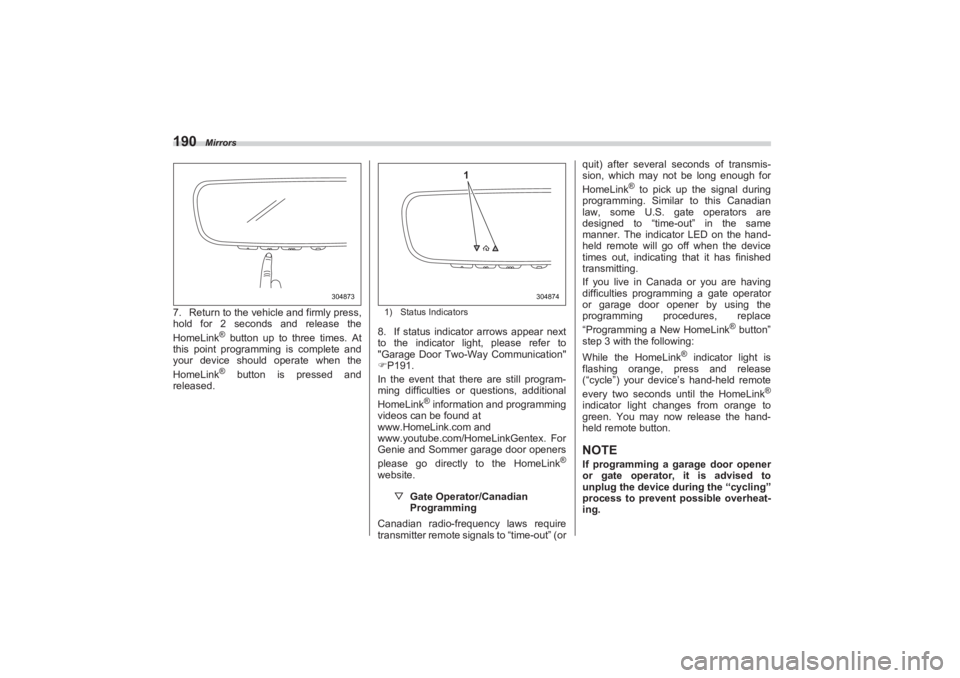
Mirrors
1907. Return to the vehicle and firmly press,
hold for 2 seconds and release the
HomeLink
® button up to three times. At
this point programming is complete and
your device should operate when the
HomeLink® button is pressed and
released.
1) Status Indicators8. If status indicator arrows appear next
to the indicator light, please refer to
"Garage Door Two-Way Communication"
P191.
In the event that there are still program-
ming difficulties or questions, additional
HomeLink
® information and programming
videos can be found at
www.HomeLink.com and
www.youtube.com/HomeLinkGentex. For
Genie and Sommer garage door openers
please go directly to the HomeLink
®
website.
▽ Gate Operator/Canadian
Programming
Canadian radio-frequency laws require
transmitter remote signals to “time-out” (or quit) after several se
conds of transmis-
sion, which may not be long enough for
HomeLink
® to pick up the signal during
programming. Similar to this Canadian
law, some U.S. gate operators are
designed to “time-out” in the same
manner. The indicator LED on the hand-
held remote will go off when the device
times out, indicating that it has finished
transmitting.
If you live in Canada or you are having
difficulties programming a gate operator
or garage door opener by using the
programming procedures, replace
“Programming a New HomeLink
® button”
step 3 with the following:
While the HomeLink
® indicator light is
flashing orange, press and release
(“cycle”) your device’s hand-held remote
every two seconds until the HomeLink
®
indicator light changes from orange to
green. You may now release the hand-
held remote button.NOTEIf programming a garage door opener
or gate operator, it is advised to
unplug the device during the “cycling”
process to prevent possible overheat-
ing.
304873
304874
1
BRZ_U.book 190 ページ 2022年3月29日 火曜日 午後3時59分
Page 200 of 432
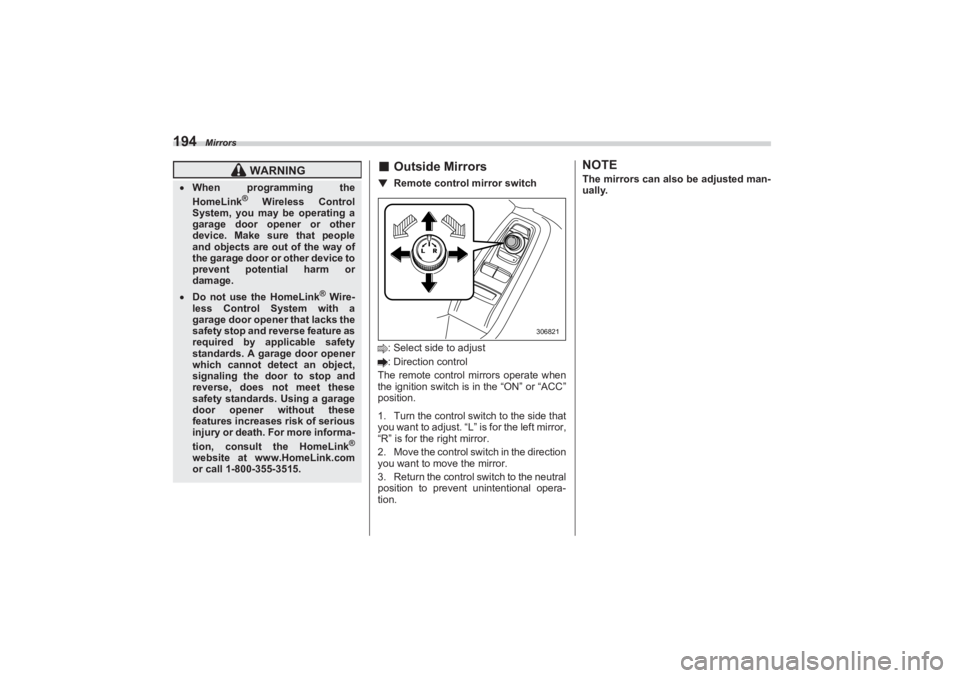
Mirrors
194
■Outside Mirrors▼ Remote control mirror switch: Select side to adjust
: Direction control
The remote control mirrors operate when
the ignition switch is in the “ON” or “ACC”
position.
1. Turn the control switch to the side that
you want to adjust. “L” is for the left mirror,
“R” is for the right mirror.
2. Move the control swit ch in the direction
you want to move the mirror.
3. Return the control switch to the neutral
position to prevent unintentional opera-
tion.
NOTEThe mirrors can also be adjusted man-
ually.
WARNING
When programming the
HomeLink
® Wireless Control
System, you may be operating a
garage door opener or other
device. Make sure that people
and objects are out of the way of
the garage door or other device to
prevent potential harm or
damage.
Do not use the HomeLink
® Wire-
less Control System with a
garage door opener that lacks the
safety stop and reverse feature as
required by applicable safety
standards. A garage door opener
which cannot detect an object,
signaling the door to stop and
reverse, does not meet these
safety standards. Using a garage
door opener without these
features increases risk of serious
injury or death. For more informa-
tion, consult the HomeLink
®
website at www.HomeLink.com
or call 1-800-355-3515.
306821
BRZ_U.book 194 ページ 2022年3月29日 火曜日 午後3時59分
Page 257 of 432

Tire Pressure Monitoring System (TPMS) (If Equipped)
251
– CONTINUED –
Starting and Operating7
■Selecting TRAC Mode and Vehicle Stability Control (VSC) ModeModes can be selected to suit your driving conditions as follows:NOTEWhen the ignition switch is turned “OFF” position af ter driving in TRACK mode,
the mode is automa tically deactivated.Driving con-
ditions TRAC modes Vehicle Sta-
bility Control
(VSC) modes Brake LSD
function Indicator lights
Normal roads Normal mode Normal mode Normal mode ―
Rough roads Off Normal mode Normal mode
Sport driving TRACK mode TRACK mode TRACK mode
Off OffTRACK mode
(AT models)
Off (MT mod-
els)
7-15. Tire Pressure Moni -
toring System (TPMS) (If Equipped)Low tire pressure warning lightThe tire pressure monitoring system
provides the driver with a warning
message by sending a signal from a
sensor that is installed in each wheel
when tire pressure is severely low.
The tire pressure monitoring system will
activate only when the vehicle is driven at
speeds above 25 mph (40 km/h). Also,
this system may not react immediately to
a sudden drop in tire pressure (for
example, a blow-out caused by running
over a sharp object).
702780
BRZ_U.book 251 ページ 2022年3月29日 火曜日 午後3時59分
Page 275 of 432
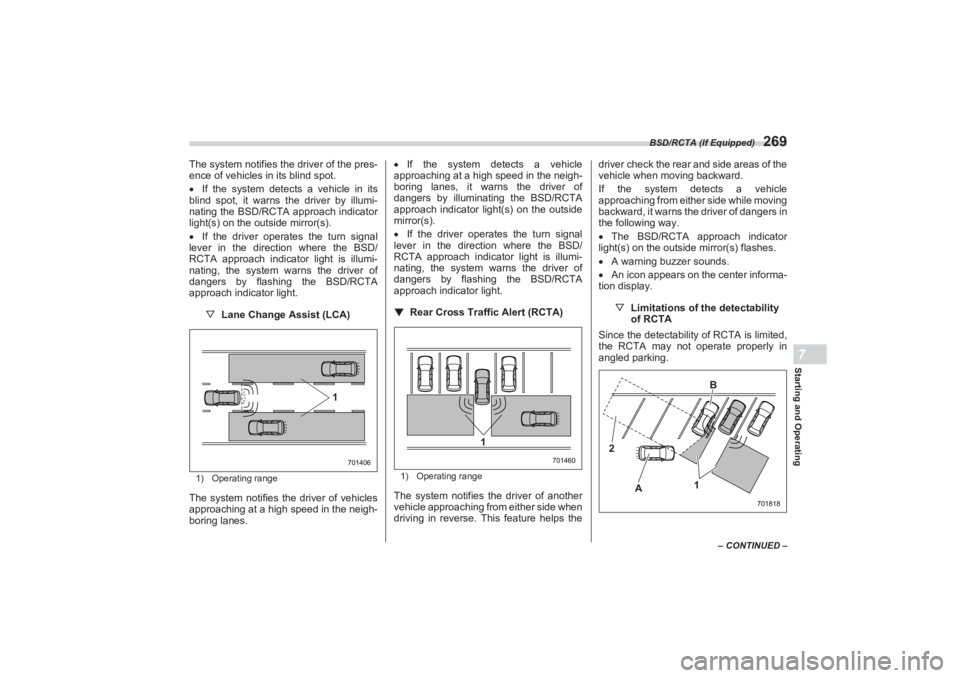
BSD/RCTA (If Equipped)
269
Starting and Operating7
– CONTINUED –
The system notifies the driver of the pres-
ence of vehicles in its blind spot.
If the system detects a vehicle in its
blind spot, it warns the driver by illumi-
nating the BSD/RCTA approach indicator
light(s) on the outside mirror(s).
If the driver operates the turn signal
lever in the direction where the BSD/
RCTA approach indicator light is illumi-
nating, the system warns the driver of
dangers by flashing the BSD/RCTA
approach indicator light.
▽ Lane Change Assist (LCA)1) Operating rangeThe system notifies the driver of vehicles
approaching at a high speed in the neigh-
boring lanes.
If the system detects a vehicle
approaching at a high speed in the neigh-
boring lanes, it warns the driver of
dangers by illuminating the BSD/RCTA
approach indicator light(s) on the outside
mirror(s).
If the driver operates the turn signal
lever in the direction where the BSD/
RCTA approach indicator light is illumi-
nating, the system warns the driver of
dangers by flashing the BSD/RCTA
approach indicator light.
▼ Rear Cross Traffic Alert (RCTA)
1) Operating rangeThe system notifies the driver of another
vehicle approaching from either side when
driving in reverse. This feature helps the driver check the rear and side areas of the
vehicle when moving backward.
If the system detects a vehicle
approaching from either side while moving
backward, it warns the driver of dangers in
the following way.
The BSD/RCTA approach indicator
light(s) on the outside mirror(s) flashes.
A warning buzzer sounds.
An icon appears on the center informa-
tion display.
▽Limitations of the detectability
of RCTA
Since the detectabilit y of RCTA is limited,
the RCTA may not operate properly in
angled parking.
701406
1
701460
1
701818
2
A B
1
BRZ_U.book 269 ページ 2022年3月29日 火曜日 午後3時59分
Page 278 of 432
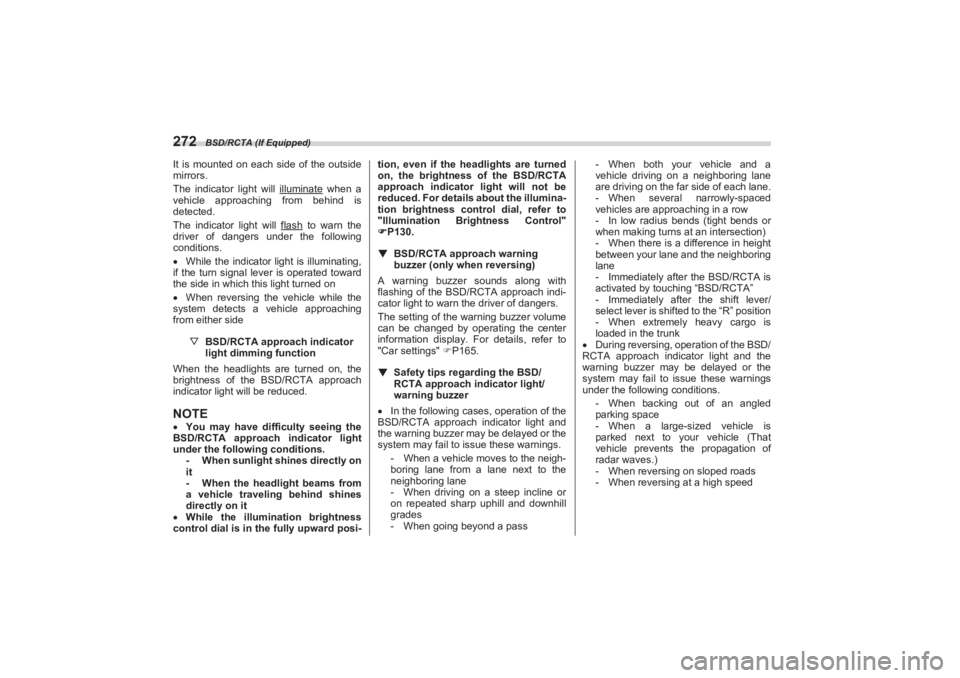
BSD/RCTA (If Equipped)
272It is mounted on each side of the outside
mirrors.
The indicator light will illuminate
when a
vehicle approaching from behind is
detected.
The indicator light will flash
to warn the
driver of dangers under the following
conditions.
While the indicator light is illuminating,
if the turn signal lever is operated toward
the side in which this light turned on
When reversing the vehicle while the
system detects a vehicle approaching
from either side
▽ BSD/RCTA approach indicator
light dimming function
When the headlights are turned on, the
brightness of the BSD/RCTA approach
indicator light will be reduced.
NOTE You may have difficulty seeing the
BSD/RCTA approach indicator light
under the following conditions. - When sunlight shines directly on
it
- When the headlight beams from
a vehicle traveling behind shines
directly on it
While the illumination brightness
control dial is in the fully upward posi- tion, even if the headlights are turned
on, the brightness of the BSD/RCTA
approach indicator light will not be
reduced. For details about the illumina-
tion brightness control dial, refer to
"Illumination Brightness Control"
P130.
▼ BSD/RCTA approach warning
buzzer (only when reversing)
A warning buzzer sounds along with
flashing of the BSD/RCTA approach indi-
cator light to warn the driver of dangers.
The setting of the warning buzzer volume
can be changed by operating the center
information display. For details, refer to
"Car settings" P165.
▼ Safety tips regarding the BSD/
RCTA approach indicator light/
warning buzzer
In the following cases, operation of the
BSD/RCTA approach indicator light and
the warning buzzer may be delayed or the
system may fail to issue these warnings.
- When a vehicle moves to the neigh-
boring lane from a lane next to the
neighboring lane
- When driving on a steep incline or
on repeated sharp uphill and downhill
grades
- When going beyond a pass - When both your vehicle and a
vehicle driving on a neighboring lane
are driving on the far side of each lane.
- When several narrowly-spaced
vehicles are approaching in a row
- In low radius bends (tight bends or
when making turns at an intersection)
- When there is a difference in height
between your lane and the neighboring
lane
- Immediately after the BSD/RCTA is
activated by touching “BSD/RCTA”
- Immediately after the shift lever/
select lever is shifted to the “R” position
- When extremely heavy cargo is
loaded in the trunk
During reversing, operation of the BSD/
RCTA approach indicator light and the
warning buzzer may be delayed or the
system may fail to issue these warnings
under the following conditions.
- When backing out of an angled
parking space
- When a large-sized vehicle is
parked next to your vehicle (That
vehicle prevents the propagation of
radar waves.)
- When reversing on sloped roads
- When reversing at a high speedBRZ_U.book 272 ページ 2022年3月29日 火曜日 午後3時59分